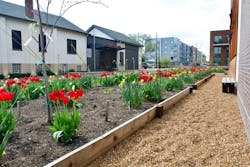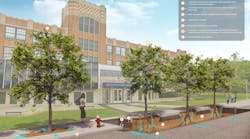About the author: Lauren Estes is associate editor for SWS. Estes can be reached at [email protected].
When an Indianapolis theater was planning an expansion, the owners knew the site’s storm water runoff management plan needed improvement. Tucked along the Indianapolis Cultural Trail and developed on what once was a historic church, IndyFringe Basile Theatre already received localized flooding in an alleyway during a normal 2-year rain event. The historic brick was impervious and had settled in places, leaving large puddles. However, in part because of the historic, centralized location, the owners wanted to incorporate a low impact development (LID) design.
Weighing the Options
The initial design draft involved a cistern to store an irrigation system that would be used to irrigate a reinforced grass parking and seating area. The proposed irrigation system would use municipal water and offer little storm water retention. An alternate design plan was proposed that would use a storm water chamber system to passively irrigate a pervious grass pavement system.
This alternate plan had the added benefits of utilizing onsite storm water and creating more permeable areas to minimize flood risk. After weighing the costs, the owners decided to move forward with the storm water chamber system design, which was projected to be similar in cost to the proposed traditional irrigation system.
Beyond minimizing flooding, the owners wanted the grass paving area to serve as a parking area and venue for outdoor events.
“Our means of getting storm water drainage was a long ways away; it was nearly a block away to be able to drain to an existing city facility,” said Lee Dykstra, retired automotive engineer and husband of the executive director of IndyFringe. “We wanted to park on the grass, but we wanted to not have cars tear it up.”
This meant that the pervious grass pavement system needed to be able to support expected traffic, while still passively irrigating and maintaining growth.
To install the permeable alley pavement, the previous historic bricks had to be individually removed and preserved.
Historical Hiccups
Located in a historic district, IndyFringe faced obstacles when it came time to remove brick from the site’s alley and replace it with a new paver alley with an open-graded aggregate base. The Indianapolis Historical Society wanted the original brick to remain on site, but the brick was deteriorating. After several meetings, the society agreed the old brick could be incorporated on the north and south ends of the alley. This agreement led to additional headaches.
“Part of the deal with the historic society was to give them the old brick that was left over,” Dykstra said. “So when you tear it up you couldn’t go in with a ball and break up the brick. We were taking individual bricks out.”
For the storm water chamber system, the available 4,800-sq-ft area was fitted with 135 chambers. The system utilized sand backfill as load support and filtration medium. In addition, the sand transmitted moisture and nutrients through capillary action into the roots of the grass paving area. D2 Land & Water Resource was the local distributor with storm water management and erosion control expertise that provided the chamber system and collaborated with the owners throughout the installation.
“This particular chamber—backfilled with the correct type of sand—it passively irrigates,” said Jim Blazek, vice president of D2 Land & Water Resource. “You just catch any rainwater that comes. Because it’s irrigation from under the ground, you use 60% less water.”
During construction, two downspouts from the existing theater were piped under the new paver alley in order to drain into the chamber field. Another two pipes were placed in preparation for the new building expansion planned. A sump was installed at the downstream end of the field to release excess water if a rain event were to occur beyond the chamber system’s capacity.
The storm water chamber system was fitted with 135 chambers across a 4,800- sq-ft area.
Topsoil Troubles
Installation of the new alleyway and storm water chamber field occurred with relatively few obstacles, with the exclusion of the historical society brick issue. It seemed the project was near completion, as the only remaining task was the installation of the reinforced permeable grass pavement. The grass pavement was designed to reduce the site’s impervious area, while still providing load support for the expected traffic of a parking area and outdoor venue. This required permeable materials that could accept water infiltration and was designed to be incorporated with the bio-filtration of the chamber system.
Installation of the new storm water chamber system and permeable grass pavement area was completed in November 2012. The grass pavement was covered with a straw erosion control mat until April 2013, and then was treated with a hydraulic growth medium and bio stimulant. The area seemed to be growing well, until it was discovered that the topsoil infill was actually composed of pulverized clay. During the subsequent construction and expansion of the theater, the storm water chamber system and alleyway held up well, but the grass pavement suffered as the pulverized clay formed plugs, clogging the system and preventing infiltration.
The system experienced chronic flooding until June 2016 when D2 Land & Water Resource and the owners of IndyFringe collaborated with a Hydrovac contractor to finally remove the pulverized clay infill from the grass paving. This process involved great care to remove the clay without damaging the passive irrigation sand fill around the chamber field. The pavers then were infilled with a validated growth media and quickly took root. After the clay was removed, the grass paving system became permeable and minimized local flooding.
With the proper topsoil medium in place and the grass pavement thriving, a new problem emerged that still is ongoing. A section of grass alongside the alley approximately 170-ft long and 35-ft wide has become contaminated where storm water runoff from surrounding sites flows, Dykstra said. On an otherwise green lawn, the contaminated area will not grow, leading Dykstra and Blazek to test the soil and search for alternate solutions. Several high-rise buildings recently have been constructed near IndyFringe and may be a contributing factor, according to Blazek.
“Some chemical from paint washing, steel washing, or staining or something got into that runoff and it’s poisoned the soil right there on the edge [of the alley],” he said.
With the exception of the contaminated area still being restored, the rest of the permeable grass paving system is performing efficiently and the storm water chamber system is passively irrigating the lawn, while providing a green space for the community to enjoy.
The storm water chamber system survived the initial site expansion, but the grass paving and clay topsoil infill created additional drainage problems.
Reaping the Rewards
Thanks to the storm water chamber field and permeable grass paving system, the owners of IndyFringe have seen a significant reduction in flooding.
“I’ve only seen one instance where the overflow worked and it was spraying water into the street,” Dykstra said. “Otherwise, it essentially works on its own.”
The storm water now is efficiently used on site and, even with the theater expansion, the area is able to handle more than 2-year rain events, which previously caused it to flood.
“We believe that we’re actually able to capture a 4-in., 1-hour event,” Blazek said. “There’s very little of the day-in-day-out storm water. If you would consider … a 2-year event, that water is never leaving that site.”
In addition to flood management, the site provides a green space for the community. The theater developed a pocket park used for picnics, fundraisers, weddings and performances. On warm summer nights, IndyFringe raises a hangar door and theater-goers can sit on the permeable grass paving area to enjoy outdoor performances.
“From the standpoint of being green and having grass in the middle of the city, it’s very nice,” Dykstra said. “People come by and set up picnics.”
As an added bonus, maintenance of the storm water chamber field, permeable grass paving system and permeable alleyway pavement is relatively simple. The grass requires regular lawn care and the alleyway needs to be cleaned and resanded every few years, depending on site conditions.
For the owners of IndyFringe, the LID design turned out to be the more economical and environmentally friendly storm water solution, in comparison to the proposed traditional irrigation system, in the long-term. The green solution provides passive irrigation and substantial benefit to the community.


